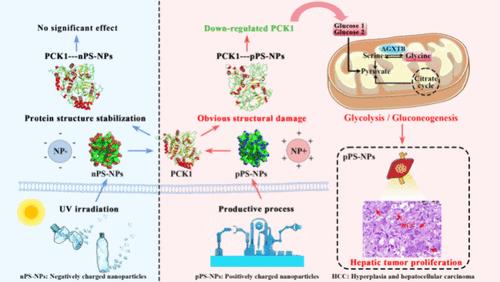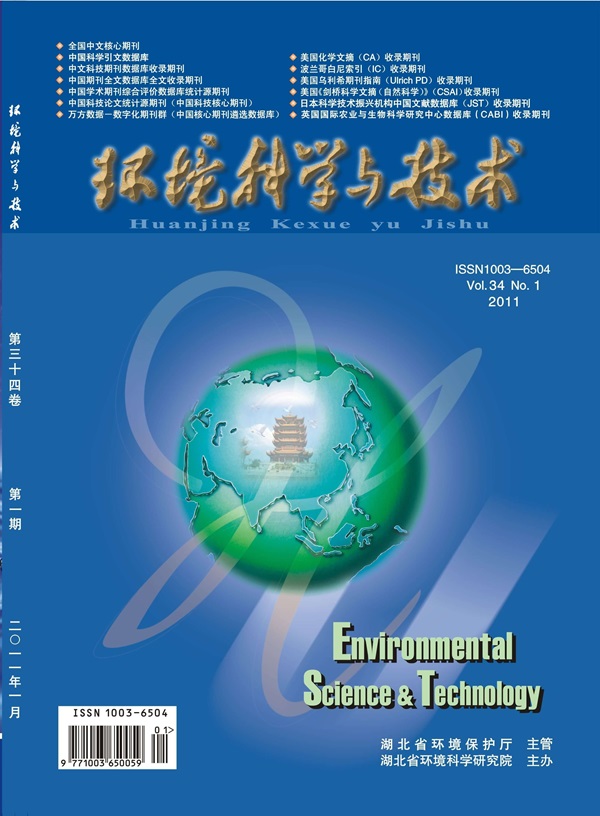Positively Charged Nanoplastics Destruct the Structure of the PCK1 Enzyme, Promote the Aerobic Gycolysis Pathway, and Induce Hepatic Tumor Risks
IF 11.3
1区 环境科学与生态学
Q1 ENGINEERING, ENVIRONMENTAL
引用次数: 0
Abstract
The production and weathering processes of nanoparticles (NPs) introduce charged functional groups on their surface. Previous studies have found that the surface charge properties of NPs play a critical role in their toxic effects and the mechanisms are generally attributed to their different accumulations and transmembrane potentials. Currently, we still lack sufficient knowledge about effects, owing to the unique structures of these polymers. In this study, positively charged NPs (PS-NH2, 50 nm) at 0.05–0.5 μg mL–1 promoted the proliferation of hepatic tumors in oncogenic KrasG12V zebrafish larvae and they also increased the viability of human hepatocellular carcinoma cells, whereas negatively charged NPs (PS-COOH, 50 nm) did not. We present evidence indicating that the potential carcinogenicity of PS-NH2 is related to the special polymer–molecular interactions caused by its positive surface charge. The affinity of PS-COOH chains for peptides typically enhances enzyme stability and upregulates its expression. However, PS-NH2 strongly competes with hydrogen bonds of the first rate-limiting enzyme PCK1 in gluconeogenesis, thus downregulating the expression of PCK1 and promoting the aerobic glycolysis pathway, which most tumor cells prefer. This study indicates that positive-charge modified NPs in the environment may bring additional carcinogenic risks.

带正电的纳米塑料破坏PCK1酶的结构,促进有氧糖酵解途径,并诱导肝脏肿瘤风险
纳米粒子的生成和风化过程在其表面引入了带电官能团。以往的研究发现,NPs的表面电荷特性在其毒性作用中起着关键作用,其机制通常归因于它们不同的积累和跨膜电位。目前,由于这些聚合物的独特结构,我们对其影响还缺乏足够的了解。在本研究中,带正电荷的NPs (PS-NH2, 50 nm)在0.05 ~ 0.5 μ mL-1范围内促进了KrasG12V斑马鱼幼鱼肝脏肿瘤的增殖,并提高了人肝癌细胞的活力,而带负电荷的NPs (PS-COOH, 50 nm)则没有这种作用。我们提出的证据表明,PS-NH2的潜在致癌性与其表面正电荷引起的特殊聚合物-分子相互作用有关。PS-COOH链对多肽的亲和力通常会增强酶的稳定性并上调其表达。然而,PS-NH2在糖异生过程中与第一限制性酶PCK1的氢键强烈竞争,从而下调PCK1的表达,促进有氧糖酵解途径,这是大多数肿瘤细胞偏爱的。本研究表明,环境中带正电荷修饰的NPs可能会带来额外的致癌风险。
本文章由计算机程序翻译,如有差异,请以英文原文为准。
求助全文
约1分钟内获得全文
求助全文
来源期刊

环境科学与技术
环境科学-工程:环境
CiteScore
17.50
自引率
9.60%
发文量
12359
审稿时长
2.8 months
期刊介绍:
Environmental Science & Technology (ES&T) is a co-sponsored academic and technical magazine by the Hubei Provincial Environmental Protection Bureau and the Hubei Provincial Academy of Environmental Sciences.
Environmental Science & Technology (ES&T) holds the status of Chinese core journals, scientific papers source journals of China, Chinese Science Citation Database source journals, and Chinese Academic Journal Comprehensive Evaluation Database source journals. This publication focuses on the academic field of environmental protection, featuring articles related to environmental protection and technical advancements.
 求助内容:
求助内容: 应助结果提醒方式:
应助结果提醒方式:


